Hippie art exploded in the 1960s with mind-bending visuals that scream freedom and peace. Artists used swirling mandalas, cosmic scenes, and nature motifs to express their rebellious spirit. Electric purples, neon greens, and sunset oranges create vibrant patterns that seem to move before your eyes! Peace symbols, flowers, and Eastern spiritual imagery appear everywhere, from concert posters to tie-dye shirts. The psychedelic movement‘s colorful legacy continues to inspire those seeking artistic liberation.
Key Takeaways
- Hippie art emerged in the 1960s counterculture, characterized by vibrant colors, swirling patterns, and cosmic imagery expressing peace and love.
- Key visual elements include mandalas, peace symbols, cosmic imagery, floral patterns, and psychedelic designs representing consciousness expansion.
- Artists like Peter Max, Victor Moscoso, and Bonnie MacLean pioneered the movement with iconic concert posters and album covers.
- Color combinations of electric purple, neon green, and nature-inspired hues create the signature vibrant, free-spirited aesthetic.
- Modern hippie art blends traditional techniques like tie-dye with digital methods, honoring past traditions while embracing new technologies.
The Origins and Evolution of Psychedelic Hippie Art
Explosion of color and consciousness, the psychedelic hippie art movement burst onto the scene in the vibrant 1960s. Deeply rooted in the counterculture’s embrace of peace, love, and mind-expanding experiences, this artistic revolution forever changed visual expression.
Artists like Peter Max splashed canvases with rainbow colors that seemed to pulse with life and energy!
The iconic peace symbol became a centerpiece of hippie art, representing the movement’s stand against war and violence. These wildly imaginative works featured swirling patterns, cosmic imagery, and natural motifs that mirrored the altered perceptions many experienced during this era.
As psychedelic art evolved, it incorporated spiritual symbols from Eastern philosophies, creating a visual language that spoke to a generation seeking deeper meaning and connection.
The resulting style wasn’t just art – it was a cultural statement!
Key Visual Elements of Free-Spirit Artistic Expression
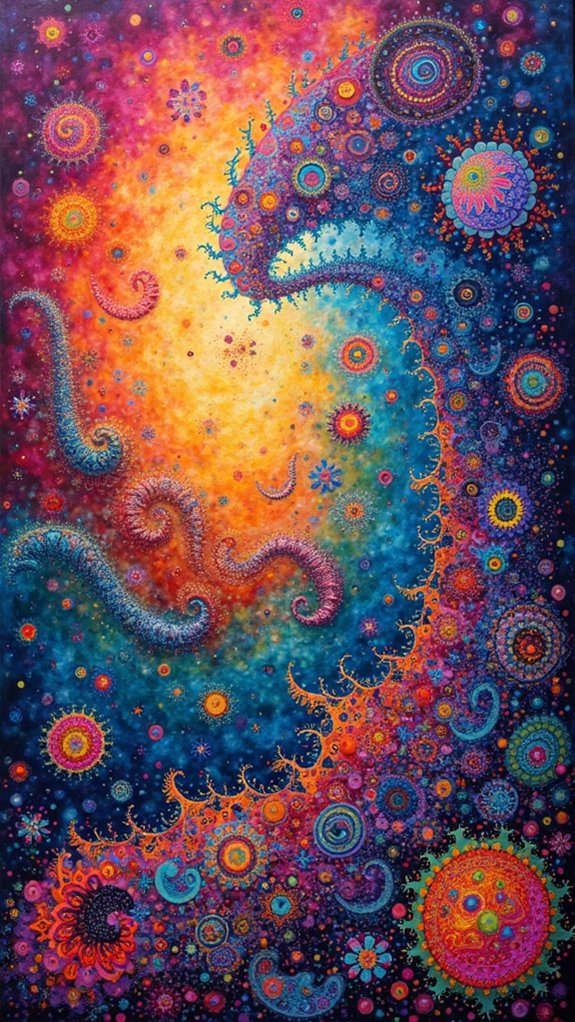
Colors explode across the canvas like fireworks in the night sky when examining hippie artistic expression! Free-spirited imagery captures the soul of the 1960s and 70s with its vibrant hues and intricate designs. These works often showcase nature scenes where peace symbols bloom alongside real flowers, creating a visual celebration of harmony.
| Visual Element | What It Represents | Where You’ll See It | How It Makes You Feel |
|---|---|---|---|
| Swirling Mandalas | Inner consciousness | Album covers, posters | Mesmerized, dreamy |
| Peace Symbols | Harmony & anti-war | Clothing, murals | Hopeful, united |
| Cosmic Imagery | Universal connection | Tapestries, paintings | Wonderstruck, tiny |
| Floral Patterns | Growth & love | Fabrics, body art | Joyful, alive |
Psychedelic patterns weren’t just random – they represented the expanding mind and breaking free from conventional thinking. These artistic elements continue to inspire today’s creators looking to capture that same sense of freedom!
Color Theory in Hippie Art: Vibrance and Symbolism
The rainbow-filled world of hippie art wasn’t just beautiful—it was meaningful! Artists carefully selected vibrant color combinations like orange and pink to express joy and the free-spirited essence of the 1960s and 70s. These weren’t random choices—each hue told a story!
Psychedelic patterns featuring electric purple and neon green swirls weren’t just eye-catching; they symbolized freedom and creativity that defined the era’s cultural movements. The hippie palette often drew from nature-inspired shades, creating peaceful vibes that connected viewers to the outdoors.
Techniques like tie-dye and fractal designs added a sense of movement, while specific color pairings—like turquoise with magenta in watercolor mandalas—represented deeper concepts of universal connection.
These color choices weren’t just groovy—they were revolutionary visual statements!
Nature Motifs and Cosmic Connections in Psychedelic Imagery
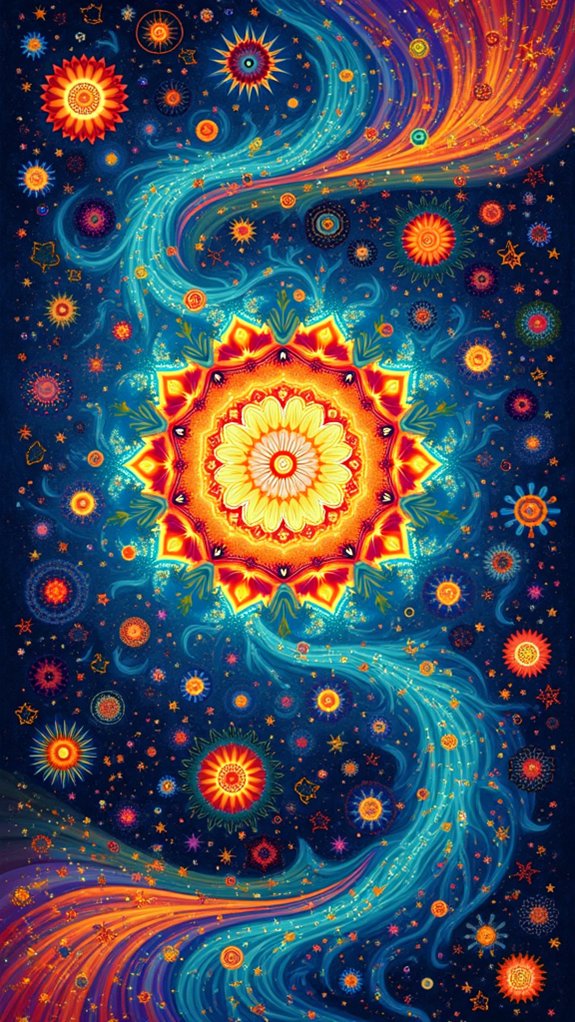
Journeying beyond vibrant colors, psychedelic art weaves intricate nature motifs and cosmic symbols that tell stories of universal connection and spiritual awakening.
Vibrant floral patterns and organic shapes dance across canvases, capturing the free-spirited essence embraced by hippie culture.
These psychedelic imagery pieces often feature meditating figures silhouetted against swirling neon mandalas, perfectly illustrating the harmony hippies sought between human consciousness and nature.
The cosmic connections appear as radiating fractals and spiraling galaxies, symbolizing our place in the universe’s grand design.
Rainbow-colored waves and flowing patterns create a sense of movement that mirrors nature’s rhythms.
These visual journeys through cosmic domains and natural environments aren’t just pretty pictures—they’re invitations to explore inner worlds and imagine a more connected existence, where peace and love flow as naturally as a forest stream.
The Role of Mandalas and Geometric Patterns
Among the most hypnotic elements of hippie visual expression, mandalas and geometric patterns stand as powerful symbols that draw viewers into contemplative states. These swirling, symmetrical designs aren’t just pretty—they’re doorways to deeper consciousness!
Psychedelic art embraces these patterns with wild, vibrant colors that seem to pulse with energy, reflecting the free-spirited essence that defined the hippie movement.
Across cultures, mandalas serve as meditation tools that promote peace and mindfulness, perfectly aligning with the hippie values of love and unity. From retro-inspired posters to trippy textile designs, these geometric patterns create a visual language that’s unmistakably tied to the 1960s and ’70s.
Whether digitally created or hand-drawn, these mesmerizing designs continue to capture the imagination, offering a kaleidoscopic glimpse into the hippie soul.
Iconic Hippie Symbols and Their Cultural Significance
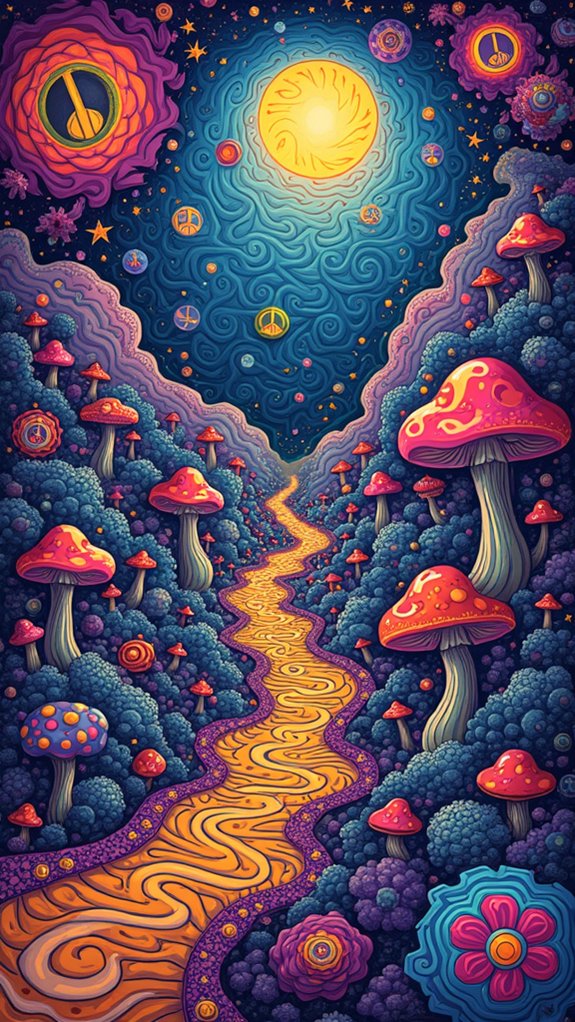
Symbolic revolution swept through the counterculture of the 1960s, creating a visual language that still resonates with people today. The peace sign, initially created for nuclear disarmament, became the ultimate hippie emblem representing anti-war sentiments and hopes for global harmony.
Talk about making a statement!
Floral patterns bloomed everywhere in hippie art, showcasing their deep connection to nature and environmental awareness. These weren’t just pretty designs—they carried messages about protecting Mother Earth and living in balance with her rhythms.
Psychedelic imagery, with its mind-bending swirls and rainbow explosions of color, reflected the movement’s exploration of consciousness.
These trippy visuals weren’t random; they symbolized breaking free from conventional thinking and seeing the world through new, more colorful lenses.
Digital vs. Traditional Techniques in Modern Hippie Art
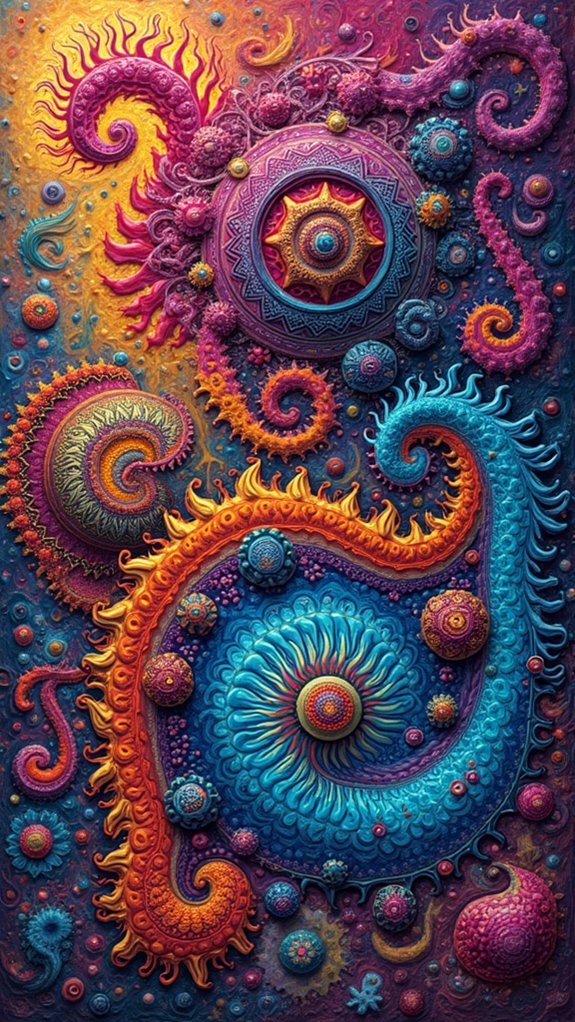
While the psychedelic swirls of the ’60s continue to inspire artists today, the tools used to create hippie art have dramatically evolved, splitting the scene into digital and traditional camps.
Digital art has exploded in popularity, letting artists craft mind-bending seamless patterns with perfect precision, and share them instantly across the globe. Wow, what a game-changer!
Yet many artists still swear by traditional techniques, cherishing the happy accidents and textured details that come from hand-painting or screen printing.
These old-school methods give artwork that authentic, touchable quality that’s hard to replicate on a screen.
The coolest thing? Many modern hippie artists bounce between both worlds, mixing digital precision with handcrafted charm to create trippy masterpieces that honor the past while zooming into the future.
How to Incorporate Hippie Art in Contemporary Design
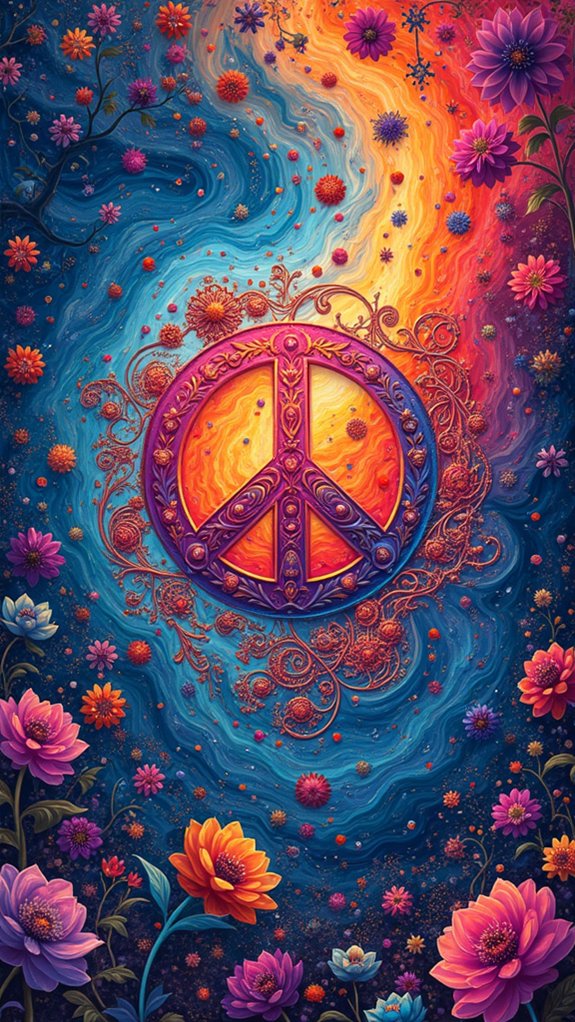
Contemporary designers blend hippie art into modern projects through digital fusion, combining psychedelic patterns with sleek interfaces for websites and apps that feel both nostalgic and fresh.
Creating sustainable boho spaces has become a popular trend, with eco-friendly materials paired with vibrant tie-dye textiles and peace symbols to transform living areas into earth-conscious retreats.
These colorful design approaches allow today’s creators to honor the free-spirited 1960s aesthetic while addressing modern concerns about sustainability and digital engagement.
Digital Media Fusion
The colorful world of hippie art has found a new home in the current digital design environment. Designers are blending psychedelic patterns with modern digital techniques to create eye-catching visuals that pop on screens everywhere.
Using royalty-free stock images from vast online collections, creators can quickly access authentic hippie-inspired artwork without starting from scratch!
Today’s digital platforms embrace these whimsical styles that combine vintage peace symbols and flowery designs with contemporary aesthetics. Website designers add colorful mandalas to landing pages, while social media marketers incorporate geometric hippie elements into their campaigns.
This fusion not only captures attention but also connects emotionally with audiences who appreciate the nostalgic, free-spirited vibe. The result? Digital spaces that feel both modern and delightfully retro, creating an immersive experience that resonates across generations.
Sustainable Boho Spaces
Creating sustainable boho spaces has never been easier thanks to the resurgence of hippie art in modern design trends! Vibrant hippie art transforms ordinary rooms into lively sanctuaries where peace and self-expression flourish. Colorful mandalas, flowing organic shapes, and psychedelic patterns work together to create an atmosphere that feels both nostalgic and fresh.
Designers are mixing high-resolution nature-inspired themes with retro elements from the ’60s and ’70s to craft spaces that celebrate freedom while remaining eco-conscious. Wall art featuring peace symbols, textiles with geometric designs, and decorative accents in bold color combinations can serve as eye-catching focal points.
These artistic elements don’t just look good—they tell a story! By incorporating these whimsical, free-spirited details, any space can achieve that perfect balance of harmony with nature while expressing individuality.
Notable Artists and Their Contributions to the Psychedelic Movement
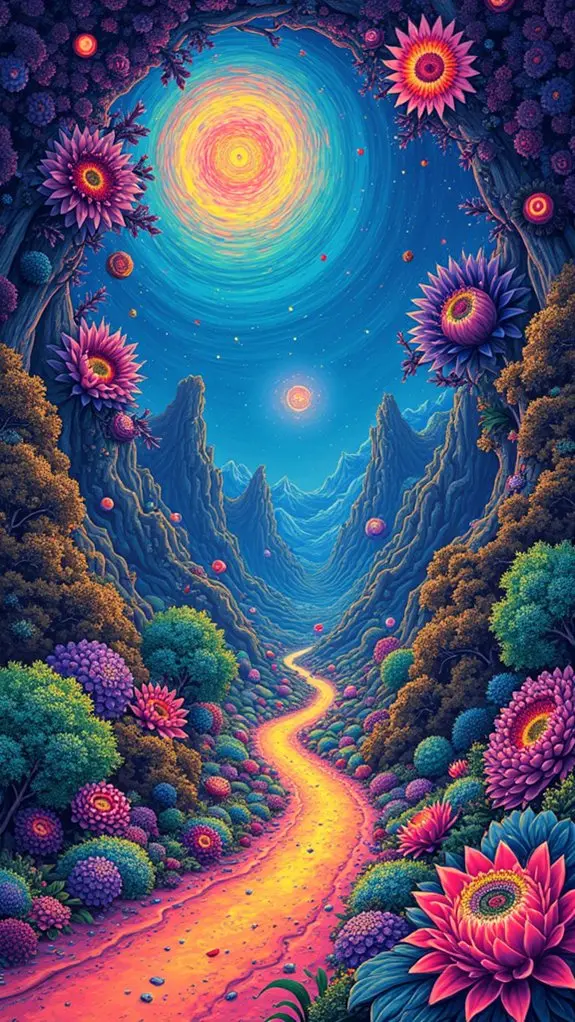
The psychedelic movement birthed remarkable visual trailblazers who transformed concert posters into mind-bending portals of imagination.
Artists like Victor Moscoso and Peter Max pushed the boundaries of perception through their consciousness-expanding art, using vibrant colors and swirling patterns that seemed to pulse with the rhythm of the music.
Beyond individual creations, these visionaries often engaged in collaborative multimedia projects, merging their artistic styles with musicians and writers to create immersive experiences that defined the countercultural revolution of the 1960s.
Pioneering Visual Trailblazers
While mainstream culture was immersed in traditional imagery during the 1960s, a bold group of visual artists emerged to completely transform the artistic terrain with their mind-bending creations.
These pioneering visionaries pushed boundaries with their psychedelic art, creating vibrant worlds that seemed to pulse with life!
- Victor Moscoso and Rick Griffin became legends with their swirling, intricate concert posters that made words dance across the page.
- Peter Max’s explosion of colors and flowing patterns captured the free-spirited essence of the counterculture movement.
- Bonnie MacLean broke barriers as a female artist, creating jaw-dropping Fillmore posters with innovative typography.
- Stanley Mouse and Alton Kelley revolutionized album art for bands like The Grateful Dead, turning record covers into trippy portals.
Consciousness-Expanding Art
Psychedelic explosions of color and form transformed American art during the 1960s as visionary artists tapped into expanded states of consciousness.
Peter Max and Victor Moscoso created mind-bending concert posters that became as protected as valuable site is protected treasures, now appearing in museums and stock photos collections worldwide.
Artists like Alex Grey and Robert Crumb pushed artistic boundaries by layering vibrant hues and swirling patterns that made static images seem to dance and pulse with life!
H.R. Giger and Yasumasa Morimura took things even further, blending surrealism with psychedelic elements to explore deeper questions about human existence.
These artists didn’t just make pretty pictures—they created doorways to new ways of seeing the world, turning ordinary gallery walls into portals of perception that continue to blow minds today.
Collaborative Multimedia Projects
Beyond individual artists working in isolation, collaborative multimedia projects became the beating heart of the psychedelic movement during the 1960s and 1970s.
Artists like Peter Max and Victor Moscoso teamed up with musicians, creating a mind-blowing fusion of colors, sounds, and ideas that defined a generation.
- The Grateful Dead’s album covers—wild, swirling masterpieces—are still protected by reCAPTCHA of artistic legacy decades later
- Pink Floyd’s concerts featured jaw-dropping light shows that turned music into a total sensory experience
- The San Francisco Poster Movement brought together dozens of artists who created eye-popping posters for concerts and festivals
- Jefferson Airplane’s visual identity was shaped by collaborations between musicians and artists who shared a vision of peace and cosmic connection
Frequently Asked Questions
How Do Psychedelics Influence Hippie Artists’ Creative Processes?
Psychedelic experiences often expand consciousness, allowing artists to access novel perceptions. These altered states frequently fuel creative expression and provide profound artistic inspiration beyond conventional boundaries of perception and technique.
Can Hippie Art Be Therapeutic for Mental Health Issues?
Research suggests artistic expression offers art therapy benefits for mental health conditions. The creativity release and visual expression characteristic of hippie aesthetics can facilitate emotional processing and reduce anxiety symptoms.
What Materials Create Authentic Hippie Art Textures?
Authentic texture creation involves mixed media techniques combining natural materials like hemp, clay, and wood with recycled elements. Fabric dyeing, beadwork, and handmade paper further enhance tactile dimensionality and visual depth.
Is Appropriation a Concern When Creating Hippie-Inspired Art?
Appropriation raises ethical considerations when creating countercultural art. Cultural sensitivity requires acknowledging source influences while artistic originality means transforming borrowed elements rather than merely copying aesthetic signifiers without understanding their significance.
How Did Hippie Art Influence Commercial Advertising?
Hippie counterculture aesthetics revolutionized advertising by infusing commercial campaigns with psychedelic visual symbolism that appealed to youth markets. Brands adopted these elements to refresh their identity and appear progressive during cultural shifts.
Conclusion
Hippie art isn’t just a colorful blast from the past—it’s a living, breathing tradition that continues to inspire today’s creators. From festival posters to digital designs, these psychedelic visions remind us to stay connected to nature, question authority, and explore our inner worlds. Whether through swirling mandalas or peace symbols, hippie art still whispers its timeless message: open your mind, follow your heart, and make the world more beautiful.

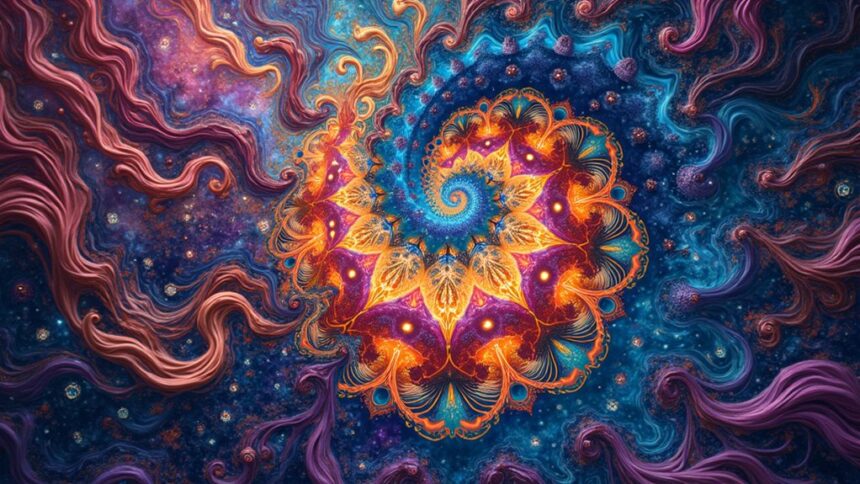
Leave a Reply